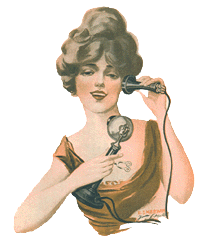Browse Online: MIT's Musical 'Inventions of Note' Sheet Music Collection
-
-
slice.mit.edu
Filed Under
Recommended
 Huge technological advancements during the late 19th and early 20th century sped up transportation and communications, plus they inspired songwriters with new routes to romance. The Lewis Music Library’s collection of sheet music from 1870 to 1920, named Inventions of Note, contains more than 50 of these pieces, all with PDF files of the scores and some with an audio link.
Huge technological advancements during the late 19th and early 20th century sped up transportation and communications, plus they inspired songwriters with new routes to romance. The Lewis Music Library’s collection of sheet music from 1870 to 1920, named Inventions of Note, contains more than 50 of these pieces, all with PDF files of the scores and some with an audio link.
“We decided to concentrate on music written about newly introduced technologies from the past such as telephones, airplanes, and automobiles," says Lewis librarian Peter Munstedt. "We encourage students to study this music to understand the impact that new technologies had on previous generations.”
 All types of flying machines celebrate love literally taking wing. “Take a sail ‘mong the stars…ride around Venus, have a spin around Mars,” entices the zeppelin air sailor in “Come Take a Trip in My Airship” (1903). “No one to watch while we’re kissing, no one to see while we spoon [cuddle], come take a trip in my air ship, and we’ll visit the man in the moon.”
All types of flying machines celebrate love literally taking wing. “Take a sail ‘mong the stars…ride around Venus, have a spin around Mars,” entices the zeppelin air sailor in “Come Take a Trip in My Airship” (1903). “No one to watch while we’re kissing, no one to see while we spoon [cuddle], come take a trip in my air ship, and we’ll visit the man in the moon.”
In “Way Up in an Aeroplane” (1910), the lady begs, “Let’s go up in an aeroplane, way up to the stars, you can flirt with the comet girl while I make love to Mars.” The frustrated beau in “Up in my Aeroplane” (1909) threatens to take his fickle lover “Up! up! up! up! Up in my aeroplane” until she says “yes,” and then “’Twill be time I guess to come down, down, down.”
New technology emboldened women to dump traditionally demure manners. A swain gets the shaft in “Call Me Up Some Rainy Afternoon” (1910) when he overhears his dear promising the same bliss to another man who has her phone number. A girl phones her boyfriend in “All Alone” (1911) and urges, “Nobody here but me, parlor’s nice and cozy…we’ll have lots of kissing, Pa and Ma have left me all alone.”
 “The Girl on the Automobile” (1905) eschews perfume for a whiff of mild gasoline. As she drives past the men, they conclude, “You can bet she ain’t timid, why she is the limit.” However, women were warned about the determined man whose car runs out of gas in an isolated spot. “Keep Away From the Fellow Who Owns an Automobile” (1912) cautions, “he’ll take you far in his motor car, too darn far from your Pa and Ma, …you must kiss him or get out and walk…”
“The Girl on the Automobile” (1905) eschews perfume for a whiff of mild gasoline. As she drives past the men, they conclude, “You can bet she ain’t timid, why she is the limit.” However, women were warned about the determined man whose car runs out of gas in an isolated spot. “Keep Away From the Fellow Who Owns an Automobile” (1912) cautions, “he’ll take you far in his motor car, too darn far from your Pa and Ma, …you must kiss him or get out and walk…”
Movies also provided cues for romance. “Take Your Girlie to the Movies” (1919) provides step-by-step advice for couples hoping to escape “cranky dad and mother’s eagle eye” plus the tattling little brother. “Take your lessons at the movies and have love scenes of your own. …Pick a cozy corners where it’s nice and dark, don’t catch influenza kissing in the park.”
On the lowest end of the technology spectrum, the couple in “The Lover’s Telegraph” (1885) employs string and tin cans to “flirt with ease, say just what you please, and exchange a kiss or two…” without alerting her stern father and the prowling bulldog. “We whisper vows so fondly soft, they’d make another laugh; a honeyed ‘yes’ is whispered oft Thro’ the lover’s telegraph.”
Learn more about MIT's Lewis Music Library.







